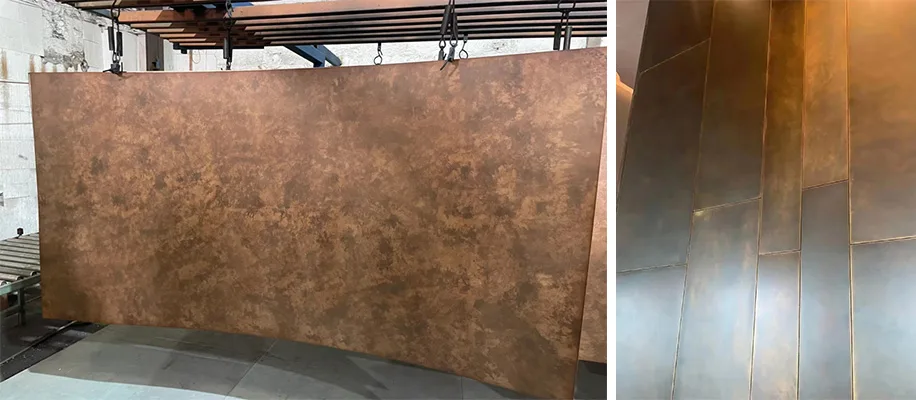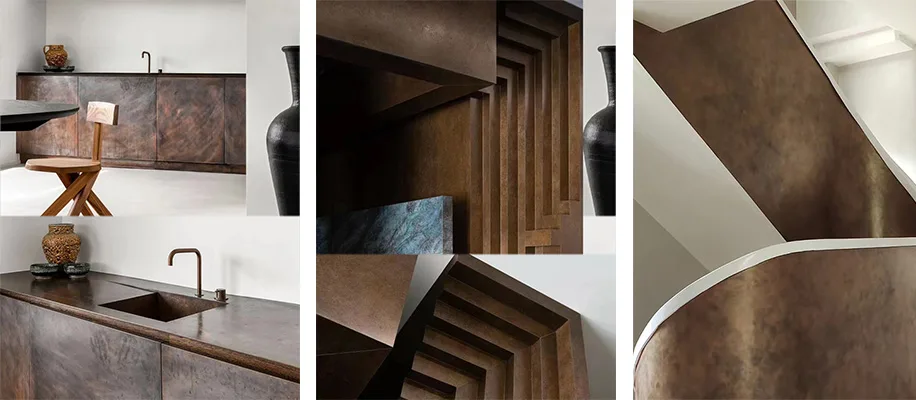Introduction
Copper, one of the oldest metals known to humankind, has been valued for its durability, beauty, and versatility for thousands of years. In recent decades, aged copper sheets have emerged as a highly sought-after material in architecture, interior design, and artistic projects. The process of aging copper naturally or artificially produces a distinctive, weathered appearance that enhances the material’s charm and adds an element of timeless elegance to any project. Whether you’re designing a building exterior, crafting artistic sculptures, or simply adding character to a home décor, aged copper sheets offer both aesthetic appeal and practicality. In this article, we’ll explore the uses, benefits, and the growing popularity of aged copper in design.

What is Aged Copper Sheet?
Aged copper refers to copper that has undergone a natural or artificial aging process to develop a patina, typically characterized by a greenish-blue hue. The change in color occurs as copper reacts with elements like oxygen, water, and carbon dioxide over time. This process results in the formation of copper oxide and copper carbonate, which protect the metal from further corrosion. While aged copper sheets are available in their pre-patinated state, they can also be aged on-site through a range of methods to achieve a similar effect.
The Process of Aging Copper
The aging of copper is a fascinating process that happens over time. Initially, copper is a shiny reddish-brown metal, but as it interacts with the atmosphere, it gradually turns into the signature greenish patina. The aging process can take anywhere from several months to several years depending on environmental conditions.
Natural vs. Artificial Aging
- Natural Aging occurs when copper is exposed to elements like rain, wind, and humidity. Over time, these factors contribute to the gradual development of copper’s patina.
- Artificial Aging accelerates the natural process using chemical treatments or exposing the copper to specific environments, such as moisture or acidic substances. This can produce an aged look quickly for projects that require a faster turnaround.
Chemical Reactions: From Bronze to Verdigris
The beautiful green color that copper achieves is called verdigris, formed by the chemical reaction of copper with carbon dioxide and water vapor. Over time, this patina provides copper with an extra layer of protection from corrosion, which is why aged copper can last for centuries.
Uses of Aged Copper Sheets
Aged copper sheets are incredibly versatile and have a wide range of applications across various industries, particularly in design and architecture.
Architecture and Interior Design
- Exterior Wall Cladding: Aged copper is frequently used in cladding the exterior of buildings. The unique patina gives a sophisticated, rustic look while also providing excellent protection against the elements.
- Roofing and Skylights: Copper is renowned for its durability, making it an ideal choice for roofing materials. As copper ages, its patina adds visual interest and contributes to the overall aesthetic of the building.
- Garden and Landscaping Features: Aged copper can be used in creating stunning garden features such as fountains, sculptures, or planters. Its ability to blend seamlessly with natural surroundings makes it a popular choice for outdoor design.

Art and Craft
- Sculptures and Artwork: The appealing patina of aged copper makes it a favorite material for sculptors and artists. The color and texture changes over time, making it a dynamic material for creating ever-evolving works of art.
- Handcrafted Jewelry and Furniture Design: Copper’s malleability makes it perfect for crafting intricate jewelry pieces or custom furniture. Aged copper adds an antique, vintage feel to any design.
Other Uses
- Creative Lighting Fixtures: Copper’s reflective properties and beautiful aged surface make it ideal for creating one-of-a-kind light fixtures. Whether used for chandeliers, pendant lights, or lamps, aged copper brings warmth and style to any room.
- Kitchen Décor: Aged copper can add a rustic charm to kitchen elements such as range hoods, backsplashes, and sinks, offering a modern yet timeless look.
Why Choose Aged Copper Sheets?
Aesthetic Value
Aged copper sheets have an undeniable aesthetic appeal. The deep, earthy tones of the patina lend an antique, sophisticated vibe to any project. The surface texture also provides a sense of history, creating a unique and one-of-a-kind look for every application. This makes copper sheets a perfect material for adding character to both modern and traditional designs.
Durability and Longevity
One of the greatest benefits of aged copper is its durability. Copper naturally resists corrosion, and once it develops its patina, it becomes even more resistant to further deterioration. This means that structures or items made from aged copper can last for decades—if not centuries—without losing their beauty or functionality.
Environmental Impact
Copper is a sustainable material that is fully recyclable, which makes it an eco-friendly choice. Using aged copper sheets reduces the need for synthetic materials and contributes to environmentally conscious design practices. Plus, copper’s long lifespan means fewer resources need to be used for replacements.
How to Age Copper Sheets for DIY Projects
If you’re working on a DIY project and want to achieve the aged copper look, there are several methods available to accelerate the aging process.
Natural Aging Method
To naturally age copper, simply expose it to the elements. Rain, humidity, and even saltwater can gradually accelerate the aging process. However, this method can take a significant amount of time, often several months to a few years, depending on your location.
Artificial Aging Method
For quicker results, you can artificially age copper using specific chemicals like vinegar or ammonia. Here’s a simple method:
- Clean the copper surface to remove any dirt or oils.
- Spray the copper with a mixture of vinegar and salt, then allow it to air-dry.
- Repeat the process until you achieve the desired patina.
Alternatively, you can use ready-made patina solutions that can be purchased online or at craft stores.
Tips for Preserving Aged Copper
While aged copper is beautiful, it’s important to protect the patina to ensure it lasts. Apply a clear lacquer or protective coating to the copper surface. This will seal the patina and prevent it from fading or peeling over time.
Conclusion
Aged copper sheets are a remarkable material that combines beauty, durability, and sustainability. Whether used in architecture, art, or home décor, copper’s timeless appeal continues to captivate designers and homeowners alike. By understanding the aging process, the many uses of copper, and how to care for this precious material, you can incorporate it into your next project with confidence. With the ability to evolve and improve over time, aged copper remains one of the most versatile materials in the design world.
